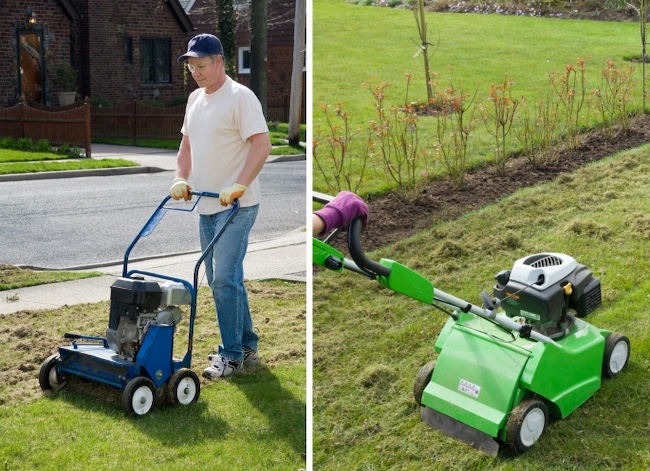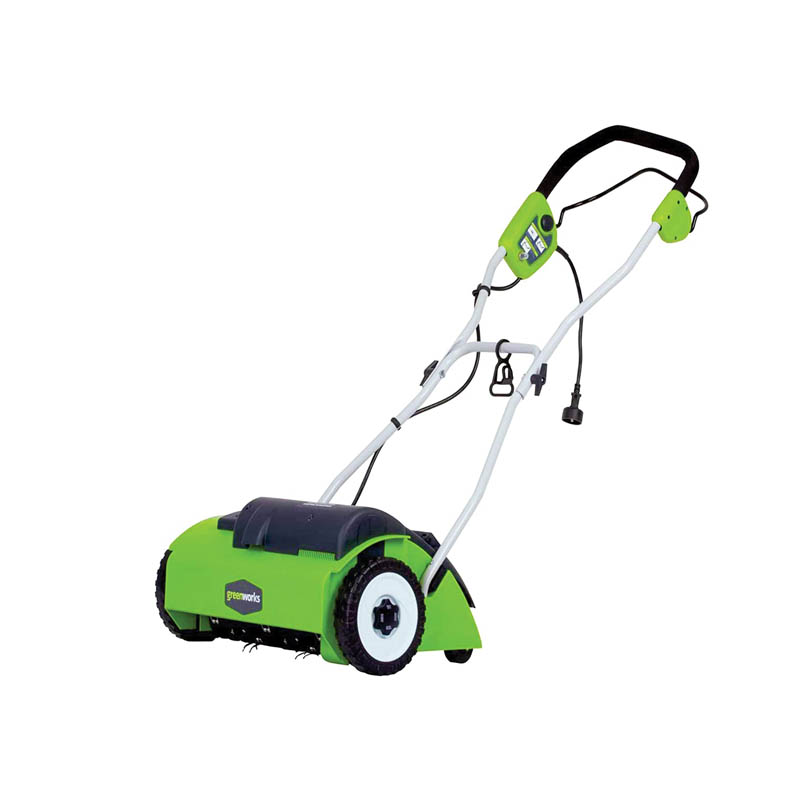

We may earn revenue from the products available on this page and participate in affiliate programs. Learn More ›
A power rake and a dethatcher are sometimes referred to interchangeably as though they are the same tool, but these garden tools differ on a few key details.
Knowing which tool to use in various circumstances makes a big difference when you are trying to clear out dead grass, excess grass clippings, and thatch buildup from your lawn.
Ahead, learn the primary differences between these two garden tools, including their mechanical differences, and the suitability of each for use by novice gardeners.
Both power rakes and dethatchers are used to remove thatch and debris buildup on a lawn.
Thatch is a buildup of organic matter that is made up of both living and dead plants, including stems, leaves, roots, and any mulch or lawn clippings that have been left behind by a mower.
This buildup can prevent new seeds from reaching the soil and it also can choke out the living grass over time.
So what’s the difference between these two tools? “Power rakes are designed for heavy-duty thatch removal, equipped with rotating blades that aggressively cut through and remove dense layers of thatch,” says Gene Caballero, co-founder of GreenPal, a Tennessee-based lawn care services company. “On the other hand, dethatchers, or scarifiers, target lighter layers of thatch. They are ideal for preventive maintenance, ensuring that thatch does not reach levels where it could impede the health and growth of the grass,” Caballero explains.
- A dethatcher is a light-duty tool used to remove thatch that is up to 1/2-inch thick.
- A power rake is a heavy-duty garden tool primarily used by professional landscapers to lift and remove thatch that exceeds 1/2 inch in thickness.
| Power Rake | Dethatcher | |
| Ease of use | Requires adequate skill to operate. Often used by professionals | Generally easy to use, suitable for beginners. |
| Price | Typically more expensive to purchase or rent. | Generally more affordable compared to power rakes. |
| Thatch removing ability | Aggressively removes thatch and debris. | Removes thatch with less intensity, may require multiple passes. |
| Suitability | Ideal for larger lawns with thick thatch. | Suitable for various lawn sizes and types of thatch. |
| Soil disturbance | Can potentially disturb soil structure. | Generally causes less soil disturbance. |
| Impact on ecosystems | Can disturb small organisms and soil structure if not used carefully. | Generally has a lower impact on ecosystems if used responsibly. |
Spring tines on a dethatcher lift a small amount of debris to the surface.

Dethatchers can come in several different types including manual, tow-behind, and powered, but all dethatchers have similar mechanisms to remove a small amount of thatch and dead organic debris from the surface of the lawn.
These light-duty garden tools have spring tines that are designed to rotate and dislodge up to 1/2 inch of thatch.
- Manual dethatchers look similar to a rake, except the metal tines are thick and perpendicular to the dethatcher handle. These tools also may have a set of wheels on either side of the tines to help move it across the surface of the lawn instead of digging into the soil.
- Tow-behind dethatchers have a similar mechanism to manual dethatchers, except they are towed behind a mower, saving the user some time and effort.
- Powered dethatchers rely on a motor to drive the spring tines, only requiring the user to push the power dethatcher like a lawn mower.

THE TOOL FOR THE JOB:
Greenworks 15″ 40V Cordless Dethatcher/Scarifier
The Greenworks dethatcher is a beast, performing just as well as (if not better than) the corded models we tested. We had no problem pulling up armfuls of thatch with each step we took. And since it only weighs 26.5 pounds, it’s easy to push. The intuitive controls are simple to use. A large depth-adjustment knob on the top of the dethatcher allowed us to switch between its five different depth levels with ease.
Our only real gripe with the Greenworks dethatcher is that the included bagger attachment is pretty useless. Bagging issues aside, if you don’t mind its steep price tag, the Greenworks is truly the way to go to dethatch your yard.
A heavy-duty blade and rotating flails on a power rake remove a lot more debris than a dethatcher.
A power rake is a much more aggressive tool than a dethatcher because it’s made to remove thatch and other organic debris from the lawn that has reached a thickness exceeding 1/2 inch.
“Power raking is reserved for situations where the lawn has been significantly neglected, with thatch severely blocking nourishment to the lawn,” Caballero explains.
The heavy-duty garden tool has a powerful motor that drives the dethatching blade and a series of rotating flails to help lift and remove the organic debris from the surface of the lawn.
These machines typically resemble square or rectangular oversized mowers, though some models have the dethatching blades partially exposed in the front of the tool.
The dethatching blades can be adjusted to the correct height to avoid damaging healthy grass and grass roots. This aggressive approach to lawn maintenance can remove up to four times more thatch material than a dethatcher.
Less aggressive dethatchers are more suitable for residential lawns.
Typically a small- to medium-sized lawn will take about one year to accumulate a thatch that is thick enough to negatively impact the health of the grass, which means that the average lawn only needs to be dethatched once a year to prevent the thickness of the thatch from exceeding 1/2 inch.
So, for small- to medium-sized residential lawns, a dethatcher is a better option than a power rake.
These light-duty tools are more than enough to remove a small amount of dead and living organic debris from the surface of the lawn and with a dethatcher there is less chance that the healthy grass and roots will be damaged by an inexperienced user.
Using a dethatcher in the spring and fall ensures that the soil is exposed and prepared for overseeding.
“Never use a power rake or a dethatcher on warm-season grasses like Saint Augustine or Bermuda. They’re just too harsh for these types [of grass]. These tools are best suited for cool-season grasses, like fescue.”
—Bryan Clayton, CEO of GreenPal,
a Tennessee-based lawn care services company
Power rakes can disturb ecosystems.
Power rakes can be an effective method for dethatching a lawn. If they’re not used properly, however, they can wreak serious havoc.
Because the mechanical action of power rakes is so powerful, it can damage the grass and underlying soil and, thus, potentially harm insects, other small organisms, and nearby plant life living within the thatch layer.
“Aggressive dethatching can disrupt habitats for birds and small critters living in your lawn,” Clayton explains. “The key is balance. Don’t go overboard, and aim to maintain a healthy ecosystem by encouraging natural lawn health, which, in turn, supports biodiversity.”
“To minimize this impact, it’s advisable to perform these tasks outside of wildlife nesting and breeding seasons and to consider if gentler lawn maintenance approaches could achieve the desired results without unnecessary disruption,” Caballero agrees.
Novices can damage a lawn with a power rake.

Power raking is an aggressive process that uses a heavy-duty blade and a series of rotating flails to cut and lift thatch that has become more than 1/2-inch thick. It can destroy the lawn if not done properly.
These heavy-duty tools are typically used by professional landscapers, but DIYers can learn how to use them effectively with a little patience, and a lot of practice.
If you’re new to lawn care, first try working with a dethatcher to become better acquainted with the process of lifting and removing thatch from the soil before trying your hand at a power rake.
Once you’ve gotten the hang of a dethatcher, and you’ve moved on to a power rake, practice using it before setting it loose on your lawn. Practice helps prevent tearing up new grass, destroying grass roots, and possibly damaging the moving parts of the power rake.
A power rake is especially useful for large lawns.
“Dethatching is typically an annual task aimed at lawn maintenance, while power raking should be approached as a corrective measure for excessive thatch buildup,” Caballero says.
Dethatching a small- to medium-sized yard is a maintenance task that DIYers should take on with some type of regular consistency, ensuring that the thatch on the lawn never exceeds ½ inch in thickness.
If your lawn is larger, however, it’s more difficult to monitor the thickness of the thatch. And without careful monitoring, parts of the lawn may develop a thicker thatch that’s more than a dethatcher can handle.
Enter the power rake. This impressive tool is designed specifically to handle thick, overgrown thatch, so users with large lawns won’t need to worry about thick patches that would present a problem for dethatchers. Just use the power rake as necessary to keep the lawn looking healthy.
Manual dethatchers are less expensive than power rakes.

Most homeowners who want to clean up their yard for yearly seeding don’t need the aggressive tearing blade and rotating flail of a power rake unless their lawns have recurring thatch problems. This is good news for homeowners, because manual dethatchers are significantly less expensive than power rakes.
The price discrepancy between these tools is due in part to the mechanical construction of the tools, but it’s also correlated with the target market for each tool.
Power rakes have a high price tag because they are typically sold to landscaping companies that can use the machines on a daily basis, while manual dethatchers are primarily sold to those who want to maintain the lawn at their home.
